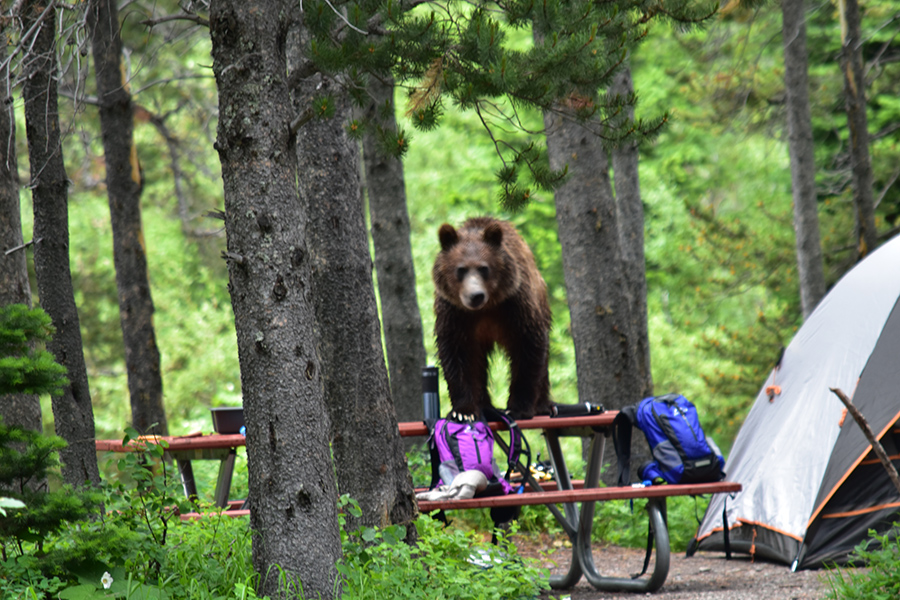A trout-stealing grizzly bear has prompted camping restrictions at one of Glacier National Park’s most popular front-country campgrounds, where park officials have enacted a temporary ban on tents and soft-sided campers in the midst of what’s predicted to be a record-breaking month for visitation.
The Many Glacier Campground was temporarily limited to hard-sided camping, including camper vehicles such as Volkswagen buses and pickup trucks with small canvas pop-ups, which are allowed as long as the canvas is not exposed.
The restrictions were put into place after an incident on June 29 at 10:30 a.m., when a small grizzly bear weighing approximately 150 pounds made its way into the Many Glacier Campground, crossed a stream and sauntered into a campsite.
The brazen bear compelled two campers to move away from a picnic table where they were cleaning two freshly caught brook trout.
One of the campers sprayed the bear with bear spray from a distance of 15 feet, according to a press release from park spokesperson Lauren Alley, but it was ineffective in deterring the bear’s approach. The bear proceeded to climb on top of the picnic table and consume the fish. It also sniffed, pawed and bit two nearby backpacks.
Park rangers responded by using hazing techniques to encourage the bear to move out of the campground. Prior to its departure, it dug into two fire pits, sniffed picnic tables, a tent, and an RV with visitors inside.
Park officials are attempting to trap the grizzly bear for further management action but had not caught it as of July 9.
However, officials used the unfortunate incident to remind visitors to familiarize themselves with bear-aware protocol, especially proper food storage while living and recreating in bear country — both for bear and human safety.
According to Alley, the bear exhibited numerous signs of food-conditioning and meets the definition of a conditioned bear in Glacier National Park’s Bear Management Guidelines.
A non-conditioned bear would typically not enter a campsite with people present, she said, and would not resist human attempts to scare it away.
Food-conditioned bears are usually removed from the population by being placed in zoos or euthanized, hence the phrase “a fed bear is a dead bear.”
Once bears have successfully obtained unnatural food from people or become accustomed to foraging in developed areas, it is very difficult to alter their behavior to return to wild areas and natural food sources. Once bears have received a human food reward, they often become a safety hazard as they become increasingly aggressive, seeking out and obtaining subsequent food rewards.
In 1976, a conditioned grizzly bear dragged a 22-year-old woman, Mary Patricia Mahoney, from her tent in the Many Glacier Campground and killed her. It was the first-ever grizzly mauling in a front-country campground in the park.
Glacier National Park has a proactive bear management program that seeks to prevent conditioning through public education, bear-wise waste management, aggressive enforcement of food storage regulations, and the use of hazing and aversive conditioning techniques to teach bears to avoid humans and stay away from developed areas.
Visitors and residents are urged to learn more about the importance of food storage while living and recreating in bear country for bear and human safety.
Tim Rubbert, a wildlife photographer and the author of “Hiking with Grizzlies: Lessons Learned,” said it’s critical for visitors to educate themselves about bears and their behavior, and to remain vigilant about food storage and garbage.
“It’s not the bear’s fault,” he said. “It needs to start with the park and its visitors.”
Rubbert said he’s been exploring Glacier National Park and Many Glacier for three decades, and has seen conflicts between bears and campers before, usually due to improper food and trash storage.
Conflicts between bears and humans can mean bad news for both the bear and the human, Rubbert said, and while wildlife managers won’t kill a bear that reacts or attacks defensively in a surprise encounter, the more unfortunate scenarios involve bears that have become conditioned and habituated to humans and their food.
By promoting education and changing policies, Rubbert said management has shifted dramatically in the past century, and especially in recent decades, when an emphasis on education has helped demystify bears and teach humans living on the widening wildland-urban interface to live in concert.
Correction: The original story stated the bear incident occurred on July 6. The correct date is June 29. The story has been updated.
